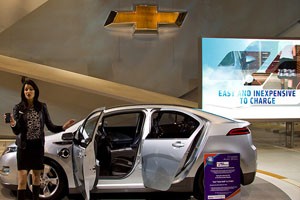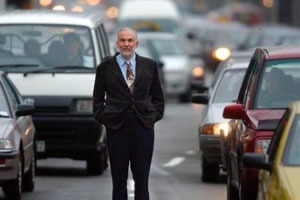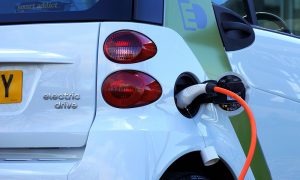Welcome to the new era. History will record that electric cars became viable again in 2011.
In 1900, there were an equal number of gas, electric and steam cars on the road, and the auto industry could have gone down any of those paths. The invention of the self-starter by Charles Kettering for the 1912 Cadillac meant no more dangerous cranking for gasoline vehicles, and the die was cast (though electrics lingered into the 1920s).
Advances in batteries, and the electronics to make them work efficiently, are drivers bringing electric cars are back from the grave, as are international environmental regulations. Beginning in December and continuing throughout 2011, we’ll see a wave of electric and plug-in hybrid car introductions. The battery cars, which include the Nissan Leaf, Coda sedan, Wheego LiFe, Ford Focus, Think City and Smart electric drive, will typically have a range of 100 miles and a plug-in time of four to eight hours on 220-volt current.
Complementing the battery cars are such illustrious plug-in hybrids as the Chevrolet Volt and Fisker Karma (which use their gas engines as generators for electric motors).
This is a big business story, and it’s an international one. Fisker is an American company but its high-performance Karma will be built in Finland and widely sold in Europe. Think is Norwegian, and the Coda and Wheego both are based on Chinese cars. Nissan’s Leaf will initially be built in Japan, but production switches to Tennessee in 2012.
For reporters on a deadline, here are some green car trends to follow in the next few months as the cars roll out:
• Fleet sales will dominate the early market. Americans can be forgiven for experiencing “range anxiety”—worrying that a car with 100-mile range will leave them stranded. A comprehensive network of public charging stations will help to ease the concern, but those will take years to build. Major companies looking to burnish their green reputations are likely to be less reluctant to jump into the market. General Electric’s Jeffrey Immelt, for instance, has committed the company to buying 25,000 EVs, including at least 12,000 Chevrolet Volts. Hertz and Enterprise are making major commitments to EVs in their rental and car-sharing fleets. Best Buy is installing EV charging stations at its stores, and soon it will be selling them (and likely cars, too). A new company called Even in Iceland has ordered 1,000 Chevrolet Equinox EV conversions, and wants 1,000 Tesla Model S cars, too. The federal General Services Administration is also a major EV fleet buyer.
• California will see 50 percent or more of first-year sales. Every consumer is eligible for a $7,500 federal tax credit, but only California offers a $5,000 cash rebate for EV buyers. The state has the perfect weather for EVs, a very green population, and by far the biggest municipal commitment, which means that charger installations there are well ahead of anywhere else.
• EVs will be expensive, and it’s the batteries! The cheapest cars will be $32,000, and they will top out well north of $100,000. Battery packs are an unavoidable $10,000 to $30,000 expense for EVs, and costs may be slow to come down with volume (though they will). Making better, cheaper batteries is one of the biggest engineering challenges of the century. Menahem Anderman, the president of Total Battery Consulting, told me, “We need batteries with higher energy density, lower cost and better durability than anything currently existing, with near-perfect reliability and safety. That is quite a challenge!”
• Public charging will cost more. It’s still early, but companies are starting to see electric car charging as a business, and that means incorporating a profit. The Car Charging Group (CCGI), for instance, which is putting in its first chargers in Florida, New York and Connecticut, intends to charge 50 cents a kilowatt hour, which is more than four times the national average of 12 cents per kilowatt hour homeowners pay. A related story is that only California currently allows EV electricity resellers to charge by the kilowatt hour. Other states are likely to fall in line, but until then companies like CCGI will have to charge by the hour—a awkward arrangement because EVs actually take in electricity at different rates.
• Automakers won’t make money initially. Some EVs are loss leaders and prestige enhancers. President Obama’s auto czar, Steven Rattner, told me that the Chevrolet Volt will cost $40,000 to build, which is an issue when the company is selling it for $41,000. The Nissan Leaf is attractively priced at $32,790, but there’s not much, if any, profit built into that. Rattner told me that electric cars “are important and they are real, but they won’t have an impact on profitability and sales for the foreseeable future.”
• Established companies have the edge. Big players such as General Motors, Nissan and Ford have a considerable advantage when it comes to achieving liftoff with electric car sales. They have the dealerships, the national advertising clout, and the name recognition that has already put “Leaf” and “Volt” into the American vocabulary. Ford has been low-profile with its electric version of the Focus (slated for delivery late next year), but by giving its EV major promotions and pride-of-place on the dealership floor it could take off quickly. Smaller players are looking for niches: Coda, which has been delayed until the second half of 2011, will concentrate on California initially. Wheego, which has just five employees, has an even more modest strategy—it’s going into the states the big players, all of which have programs aimed at a handful of metropolitan areas, are ignoring. “The Volt will be in eight markets and the Volt in 10,” Wheego CEO Mike McQuary told me. “It looks like I’ll have a lot of cities to myself.”
Another major trend, of course, is guessing how big the early EV market will be. The predictions are all over the map, and often colored by politics. If you like green cars, you’re likely to see them around every corner. But we’ll know the truth soon enough.











